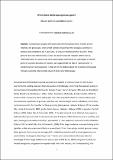Files in this item
Where have all the (ape) gestures gone?
Item metadata
| dc.contributor.author | Byrne, Richard W. | |
| dc.contributor.author | Cochet, Hélène | |
| dc.date.accessioned | 2017-07-01T23:49:07Z | |
| dc.date.available | 2017-07-01T23:49:07Z | |
| dc.date.issued | 2017-02 | |
| dc.identifier | 244334601 | |
| dc.identifier | 9ae0c2ce-4689-4128-86c9-f7d58ab43b4a | |
| dc.identifier | 84976500574 | |
| dc.identifier | 000395057300008 | |
| dc.identifier.citation | Byrne , R W & Cochet , H 2017 , ' Where have all the (ape) gestures gone? ' , Psychonomic Bulletin & Review , vol. 24 , no. 1 , pp. 68-71 . https://doi.org/10.3758/s13423-016-1071-0 | en |
| dc.identifier.issn | 1069-9384 | |
| dc.identifier.other | ORCID: /0000-0001-9862-9373/work/60630564 | |
| dc.identifier.uri | https://hdl.handle.net/10023/11132 | |
| dc.description.abstract | Comparative analysis of the gestural communication of our nearest animal relatives, the great apes, implies that humans should have the biological potential to produce and understand 60–70 gestures, by virtue of shared common descent. These gestures are used intentionally in apes to convey separate requests, rather than as referential items in syntactically structured signals. At present, no such legacy of shared gesture has been described in humans. We suggest that the fate of “ape gestures” in modern human communication is relevant to the debate regarding the evolution of language through a possible intermediate stage of gestural protolanguage. | |
| dc.format.extent | 4 | |
| dc.format.extent | 321159 | |
| dc.language.iso | eng | |
| dc.relation.ispartof | Psychonomic Bulletin & Review | en |
| dc.subject | Communication | en |
| dc.subject | Gesture | en |
| dc.subject | Great ape | en |
| dc.subject | Language origin | en |
| dc.subject | BF Psychology | en |
| dc.subject | Experimental and Cognitive Psychology | en |
| dc.subject | Arts and Humanities (miscellaneous) | en |
| dc.subject | Developmental and Educational Psychology | en |
| dc.subject | T-NDAS | en |
| dc.subject.lcc | BF | en |
| dc.title | Where have all the (ape) gestures gone? | en |
| dc.type | Journal article | en |
| dc.contributor.institution | University of St Andrews. School of Psychology and Neuroscience | en |
| dc.contributor.institution | University of St Andrews. Centre for Social Learning & Cognitive Evolution | en |
| dc.identifier.doi | 10.3758/s13423-016-1071-0 | |
| dc.description.status | Peer reviewed | en |
| dc.date.embargoedUntil | 2017-07-01 |
This item appears in the following Collection(s)
Items in the St Andrews Research Repository are protected by copyright, with all rights reserved, unless otherwise indicated.

